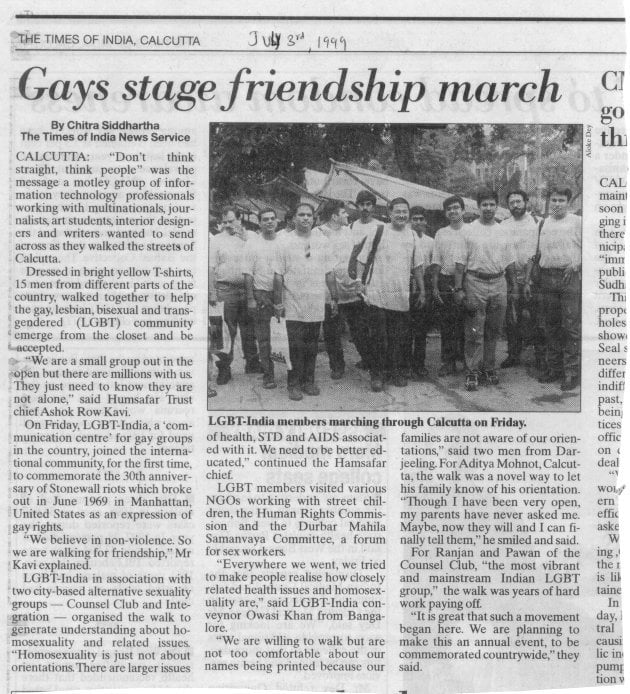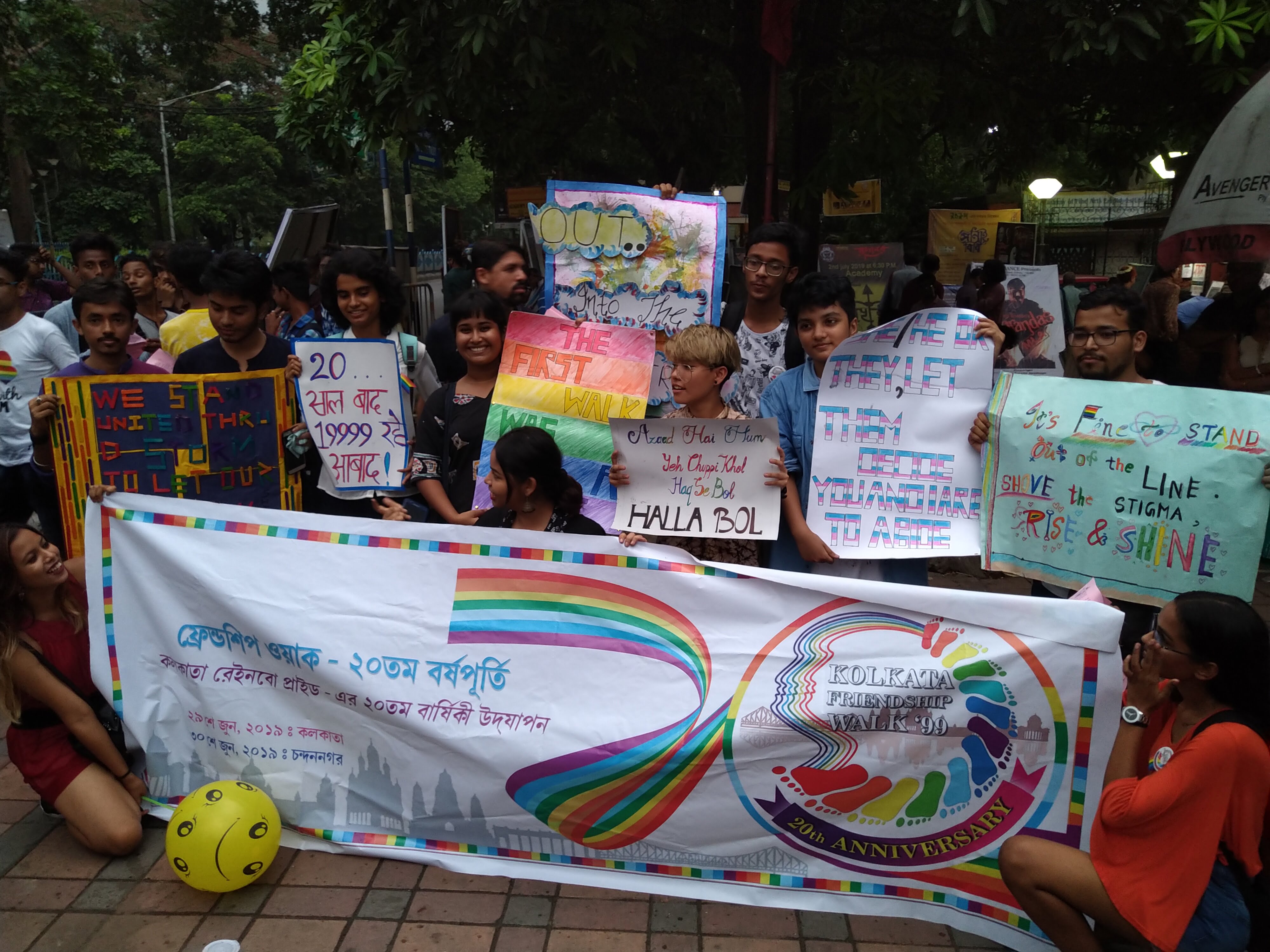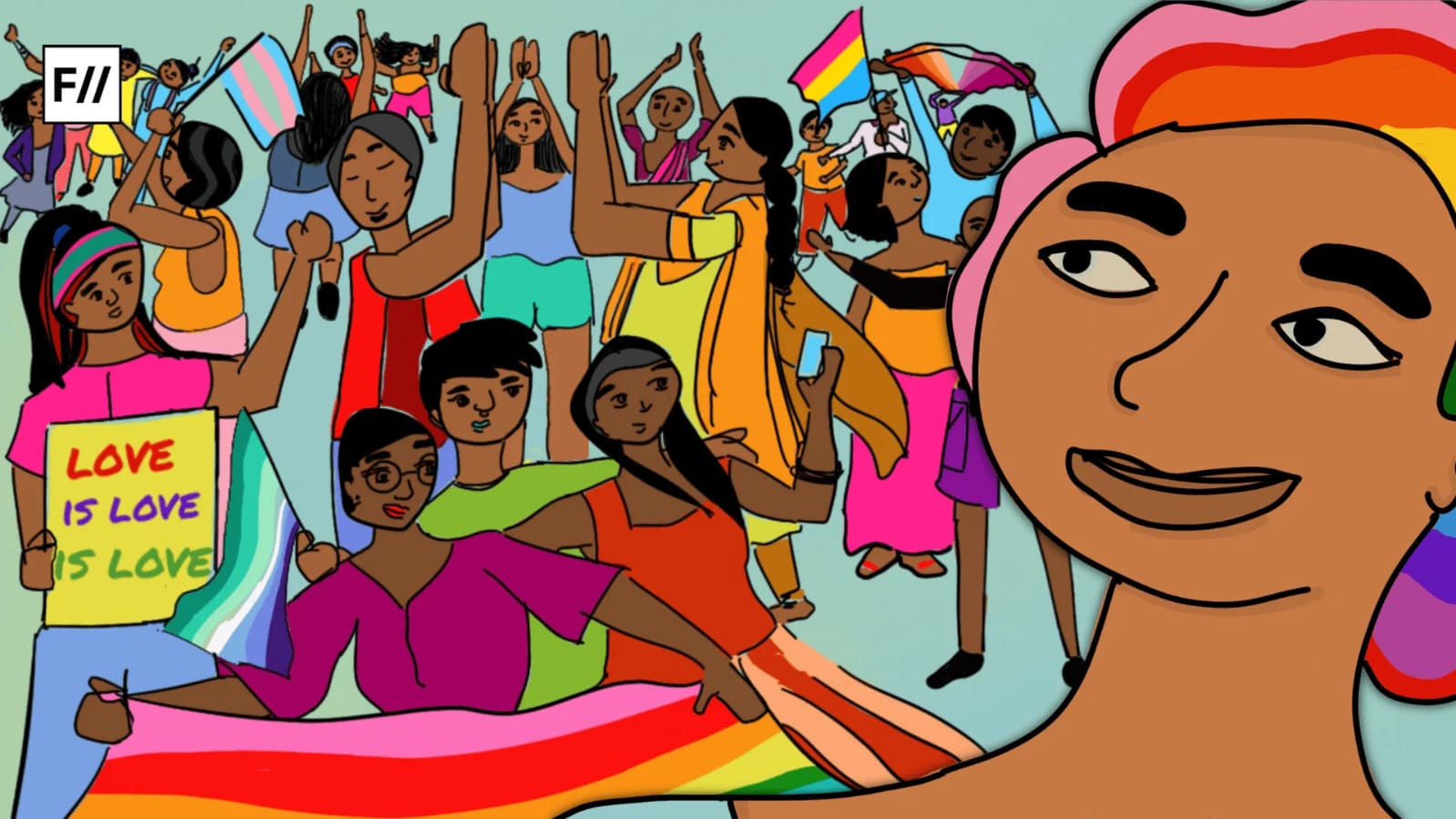It was raining on the second last day (29 June, 2019) of the Pride Month. This day is marked as the day of a historic, revolutionary celebration of the Pride Walk in South Asia for the first time which was celebrated in the city of Kolkata, in the year 1999. It was the 20th year of the Pride Walk, which was then known as “Friendship Walk”.

It was on the afternoon of 2nd July in 1999 when 15 brave-heart people gathered at the Park Circus Maidan situated in the heart of the city. They started their walk with the vision of increasing visibility of queer sexualities during that time. By wearing bright yellow T-shirts, the walk was organised to bring attention on behalf of the LGBT community and their rights in the public spaces.
Twenty years later, the walk which was started by 15 people, has expanded dramatically with 1000 to 3000 people participating in the Pride walk from different parts of the country. Every year few other cities get added in the list of Pride Walk bringing to the forefront not only the community’s visibility but also paving the path for equal rights for Queer people, which still continues to be a challenging task. Amritsar city is the latest city to get added in this Pride Walk list on 24th June, 2019. As the fight continues, which is far from being over, let us understand what had given rise to the revolution to happen twenty years back.

With the emergence of women’s movement in the early 1960s against the male supremacy, ‘Stonewall Riots’ took place in New York on 28-29th June, 1969. It was organised against the police raid and the harassment and extortion faced by the queer community in their everyday lives. The gay community was marked and targetted with discussions around HIV-AIDS. The disease which further was attached to stigmatisation and knowing for non-safe sex. The 1960s and the preceding decades were not welcoming for the gay, lesbian, transgender Americans. Same-sex relations were still considered to be illegal in New York City. ‘Stonewall Riots’ encouraged the Gay Rights movement in the United States and around the globe.
It was in Februay, 1999 that the idea of queer pride walk was first pitched at the “Yaariyan” conference that took place in Hyderabad by the queer activist Owais Khan.
This walk was considered to be the first walk that celebrated LGBTQ+ community worldwide, and in order to commemorate the walk in India, the Queer Pride marches took place on 2nd July, 1999, after 30 years of the incident.
What happened after thirty years of the ‘Stonewall Riots’ in India, and specifically in Kolkata which led the way for the first Pride March in the city? The other question that arises is the mobilisation of 15 people in the time when there was no social media or mobile technology. Today creating a Facebook event and sharing messages in WhatsApp groups and among community friends have become easy to bring people at one safe public space. But the same was not feasible twenty years back.
It was in Februay, 1999 that the idea of queer pride walk was first pitched at the “Yaariyan” conference that took place in Hyderabad by the queer activist Owais Khan. The primary motivation was to create visibility for the queer community, for which it was named as ‘Friendship Walk, 99’ to make it sound more inclusive and welcoming.

Pawan Dhall, a long-time Queer organiser in Kolkata, thinks that calling the march as LGBT Pride March “might seem to be too overt”. Again, calling it as a “Human Rights March might be too diffuse”. Thus, the term ‘Friendship Walk’ sounds “innocuous, un-militant and welcoming.” In those days, due to the lack of mobile phones and social media apps, Queer meetings happened via telephone and Yahoo group messengers, where the planning and discussions for a Pride Walk amid the city were conducted with loads of anticipation and anxiousness.
Also read: In Photos: Mumbai’s First Pride March Post 377 Ruling
Twenty years later, the walk which was started by 15 people, has expanded dramatically with 1000 to 3000 people participating in the Pride walk from different parts of the country.
Further, the walk took place in the same tenure soon after the controversy around the film ‘Fire’ in 1998-99, which also spur the Queer movement in India. Deepa Mehta’s film stormed in theaters with many angry protesters agitating against the movie and demanding its ban on its release and shows.

At that time, Kolkata was few of the last cities which was left alone and where such troubles were not taking place. The year 1999 also witnessed the establishment of Sappho, a support group for lesbians, bisexual women and trans men in Kolkata, the first in Eastern parts of India. All these steps were taking place simultaneously, which therefore paved the way for the first organisers to take on the Friendship Walk in the city.

Also read: In Photos: Chennai Rainbow Self-Respect Pride 2019
I have been part of few Pride Walks in Kolkata as well as in other cities, but even after scrapping of Section 377 on 6th September 2018, there still remains rampant stigma, harassment and discrimination against the LGBTQ+ community. Slogans like “Kaunsa Kanoon Sabze Battar, Teen Sau Sathattar, Teen Sau Sathattar (Which law is the worst?, It is three 377)” might not be said in the Pride walks anymore. But that does not change the everyday lives of the Queer community who frequently face prejudiced behaviour and violence. There is a long run yet to complete before paving the way for equal rights and safe space for the community in every sphere of Queer lives.
Sayani is a PhD Scholar in TISS, Guwahati Campus. Though she is trained in Psychology,she is more keen into Gender and Sexuality Studies. However, she often uses the lens of Mental Health and Social Behaviour in several observations and critical analysis. You can follow her on Facebook.
Photography credits to Sayani Basak
About the author(s)
Guest Writers are writers who occasionally write on FII.




